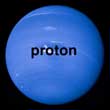 [UPDATE: Well, now that I took the page down I've been hearing from teachers who found it useful even if it is a little inaccurate. So, when I get a little time I'm going to put something back here that will hopefully please everyone. Stay tuned.]
[UPDATE: Well, now that I took the page down I've been hearing from teachers who found it useful even if it is a little inaccurate. So, when I get a little time I'm going to put something back here that will hopefully please everyone. Stay tuned.]
So I used to have a page here that was a demonstration of how much empty space there is inside a hydrogen atom. It was based on something called the "Bohr model" of the atom, where you imagine the atom as a nucleus with electrons orbiting around it - kind of like a tiny solar system. The Bohr model has been obsolete for ages, but they still teach it in schools because it's a simple introduction to quantum physics and you can move on to more accurate models later.
The page had a picture of a proton that was one thousand pixels wide, and a little electron that was only one pixel wide, and they were separated by fifty million pixels of empty space - I worked it out that that was eleven miles if your monitor displayed 72 pixels per inch, not uncommon at the time. You could try to scroll between them and it would take a long time. It was kind of neat.
Keeping it working with various web browsers was a bit of a challenge. People who make web browsers don't often start with the assumption that their browser should be able to display a web page eleven miles wide, as this is an uncommon size. I had to trick them a bit to get them to display fifty million pixels worth of anything, and of course they don't all work the same way as each other. And once in a while a new version of the browser comes out, and for whatever reason, some of the newer ones show the distances inaccurately again, which kind of defeats the point.
The other thing about the page is that it wasn't, strictly speaking, correct, as people who know Real Physics would periodically write and tell me. Some were simply pointing out that the Bohr model itself is not correct, but others have taken issue with the values used, in particular for the size of the electron. The trouble is that an electron cannot be said to have a well-defined "size" in the way that an apple or a basketball does. If you ask the internet how big an electron is, you won't get a straight answer. It doesn't have a radius so much as it has a kind of a hazy area it occupies. (I'm put in mind of the way Google Maps works on my phone - it can't pinpoint me exactly, so it draws a big circle, inside of which it is reasonably certain that I currently am. The size of that circle is usually many blocks wide at least. And that's all the map knows about me - from its point of view, my current height or weight have no real meaning whatsoever. I am the circle. The circle is not a very accurate representation of me, but it's the best the map can do. Similarly, our ideas about the tiny waves/particles/energy-constructs that make up our universe are merely mathematical constructs based on available data.)
I couldn't remember where I'd gotten my value for the size of the electron in the first place, so I re-scoured my college physics text and other sources and came up empty. I suspect that I wound up calculating something using the relative rest-masses of an electron and a proton and then comparing to the slightly-better-defined radius of the proton. Buuuut... rest mass isn't really an accurate way of thinking about the amount of Stuff in an electron, either. The point of the exercise was to visualize How Much Stuff versus How Much Emptiness, but, the more I try to figure out what will be a good way to represent that, the more I run up against the troublesome fact that "Stuff" and "Emptiness" are not so meaningful at this scale. It's like trying to measure ripples in a pond.
So, I've taken the page down, at least for now. You can still enjoy the similar, but accurate and functional, page about our solar system. I continue to be fascinated with how un-solid a solid object, such as myself, reveals itself to be upon closer inspection. Whether we're loose collections of dust in a wind tunnel or ripples on the surface of a pond, I maintain that we can only barely be said to exist.
We are all phantoms.